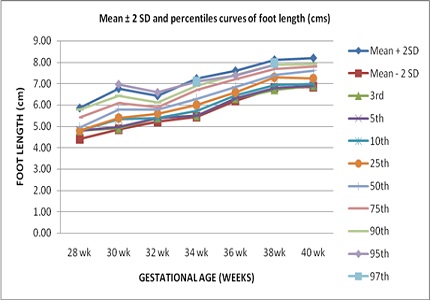Assessment of gestational age using anthropometric parameters: an observational study in India
Abstract
Introduction: The gestational age of newborn is assessed by standard method New Ballard’s score but it can also be assessed by some other simple parameters which are less time consuming and significantly correlate with gestational age.
Material and Methods: The study population included 209 consecutive live born singleton newborn of 28-40 weeks of gestation. Data were recorded and analyzed by applying correlation and regression analysis. Regression equation was derived to predict gestational age from foot length and mid upper arm circumference (MUAC).
Result: The foot length, MUAC and nipple to umbilicus distance correlated very well with gestational age with R2=0.7843, 0.7832 and 0.6630 respectively and when used in combination i.e. foot length and MUAC as R2= 0.833.The quadratic regression equation obtained was Y=0.006X2 – 0.174X + 5.081 (Y is gestational age and X is the mean of foot length and MUAC).
Conclusion: Foot length is an easy parameter and can be used as a proxy measure for New Ballard’s score. Foot length and MUAC when used in combination can be used as a better and reliable guide for gestational age assessment of newborn. Also, the foot length, MUAC and nipple to umbilicus distance at cut-off value of 7 cm, 7 cm and 8 cm respectively can be used as ready reference for gestational age assessment of newborn at 34 weeks.
Downloads
References
2. Savitz DA, Terry JW Jr, Dole N, Thorp JM Jr, Siega-Riz AM, Herring AH. Comparison of pregnancy dating by last menstrual period, ultrasound scanning, and their combination. Am J Obstet Gynecol. 2002 Dec;187(6):1660-6.
3. Ballard JL, Khoury JC, Wedig K, et al: New Ballard’s score. Infants. J Paediatric 1991; 119:417-423. [PubMed]
4. Moraes CL, Reichenheim ME. [Validity of neonatal clinical assessment for estimation of gestational age: comparison of new ++Ballard+ score with date of last menstrual period and ultrasonography]. Cad Saude Publica. 2000 Jan-Mar;16(1):83-94. [PubMed]
5. Mullany LC, Darmstadt GL, Coffey P, Khatry SK, LeClerq SC, Tielsch JM. A low cost, colour coded, hand held spring scale accurately categorises birth weight in low resource setting. Arch Dis Child2006; 91:410-13. [PubMed]
6. Sreeramareddy CT, Chuni N, Patil R, Singh D, Shakya B. Anthropometricsurrogates to identifylow birth weightNepalese newborns: a hospital-based study. BMC Pediatr. 2008 Apr 25;8:16. doi: 10.1186/1471-2431-8-16.
7. Tanis R Fenton,Roseann Nasser, Misha Eliasziw, Jae H Kim, Denise Bilan,and Reg Sauve. Validating the weight gain of preterm infants between the reference growth curve of the fetus and the term infant BMC pediatrics 2013, 13:59. doi: 10.1186/1471-2431-13-92.
8. Thomas F. Baskett,Fritz Nagele. Naegele's rule: a reappraisal. British Journal of Obstetrics and Gynaecology. November 2000; 107:1433-1435. 10.1111/j.1471-0528.2000.tb11661.x
9. Rajat Thawani, Pooja Dewan, Rajeev Kumar. Estimation of gestational ageusing neonatal anthropometry: A cross-sectional study in India. J Health Popul Nutr.2013 Dec; 31(4): 523-530.
10. Shilpi Singhal, Anurag Tomar, Rupesh Pasand, ALok Purohit. A simple tool for assessment of gestational age in newborns using foot length. J of Evolution of Med and Dent Sci. / Vol.3/ Issue 23/ June 09, 2014. P.6424-29.
11. Satarupa mukherjee, Prithvish, Souvik mitra and Sukanta chatterjee. Measuring newborn foot length to identify small babies in need of extra care: a cross sectional hospital based study. Iran J Pediatr.2013 oct; 23 (5):508-512.
12. In 2013, E. Nabiwemba, Merchant T, Namazzi G et al. identifying high-risk babies born in the community using foot length measurement at birth in Uganda. Child care health dev. 2013; 39 (1):20-6.
13. Mullany LC, Darmstadt GL, Khatry SK, et al. Relationship between the surrogate anthropometric measure, foot length and chest circumference and birth weight among newborns of Sarlahi, Nepal. Eur J clin Nutr. 2007; 61(1):40-46.

Copyright (c) 2017 Author (s). Published by Siddharth Health Research and Social Welfare Society

This work is licensed under a Creative Commons Attribution 4.0 International License.


 OAI - Open Archives Initiative
OAI - Open Archives Initiative


